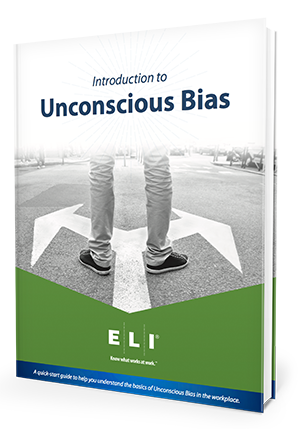Unconscious bias can be a difficult topic to explain and define. After all, if something is unconscious, how do you even know that it exists? To shed some light on the issue and increase understanding, we’ve put together five real-world unconscious bias examples.
1. HELP! My video is upside down.
Many times we think the meaning of unconscious bias as relating to race or age, but it covers a much broader spectrum, and no one, it seems, is immune to stumbling over it. Google supplied an excellent example of how even a simple bias can affect your business.
When YouTube launched the video upload feature for their app, 5-10% of videos were uploaded upside-down, and Google developers were baffled. Could such a large percentage of users be shooting their videos incorrectly? “Incorrectly” was the keyword.
Google engineers had inadvertently designed the app for right-handed users. They never considered the fact that phones are usually rotated 180 degrees when held in a user’s left hand.
With the help of unconscious bias, Google had created an app that worked best for right-handed users and never addressed the possibility of a left-hand user. We think Google needs a little more diversity on their team …any left-handed engineers need a job?
2. This candidate sounds great!
Unconscious bias in the workplace can, unfortunately, be a very common scenario. Resumes, for example, are a consistent source of unconscious bias. Resumes are a consistent source of unconscious bias. One particular study gave a group of managers a set of resumes. Some of them were exact duplicates where only the names had been changed. Resumes with the Anglo-sounding names received substantially more callbacks than those with diverse names of other origins.
Clearly, it was the names and their associated biases that impacted the decisions instead of the qualifications and value they could bring to the company.
Activities were another source of assumptions. Those that sounded more prestigious, like polo or horseback riding vs. basketball or softball, skewed the perception of the candidate. Those engaged in more prestigious sounding activities were considered more refined and successful than their counterparts, simply because of their perceived financial status.
These conclusions may have very well been valid, but they could just as easily been untrue. An interviewer’s bias makes a substantial difference in the selection arena. Very talented applicants would have been turned away for unfounded reasons.
Explore These Popular Posts from the ELI Blog

Establishing a Culture of Civility: Insights from SHRM24
In late June, I spoke at SHRM’s annual conference in Chicago where more than 25,000 people were in attendance. A major theme of the event,

75 Years of Creating Commonality
Last month, I spoke at the 75th SHRM conference, which, as always, was energizing and well run. There were more than 23,000 people in attendance, which I think is a record.
3. She’s not great with computers.
Assigning a project with a significant technical component? The best choice is a Generation Y-er, not the Baby Boomer, right? This could be an accurate assumption, but it’s not always the case. It’s not wise to base a decision on an idea or belief that doesn’t have the facts to support it.
There are many times when a manager or employee will frame their unconscious bias as common sense. However, your Xbox playing, mobile app developing Baby Boomer may be more tech-savvy than most.
By assigning the project to a younger, less experienced employee, you could potentially sacrifice quality or miss out on an innovative idea. Evaluating competency based on age is a common mistake and one that could be costly to your company.
4. You remind me of someone I know.
Examples of unconscious bias in the workplace are common. Have you ever worked with or hired someone who reminded you of another person? It’s a subtle, but real form of unconscious bias. The feelings and opinions you associate with another person can easily influence the way you see someone else.
Leaders have the responsibility to put aside past experiences and see the person as an individual. This can be difficult at times, so leaders should feel comfortable enough to ask for others’ input. Letting a past experience shape your current decisions is unfair to you, the potential employee, and the company.
5. He speaks the language.
A manager has a high-profile urban project that needs a qualified project manager to get the job done and uses “common sense” to select an African American project manager. When asked about the decision, the manager states that his choice “is a great fit” and “speaks the language.”
It’s not overtly racist; it’s simply an assumption that because this person is African American, he must be more familiar with the urban environment and the issues the community faces. The reality may be that this African American project manager grew up in the suburbs, went to private school, played polo and has had no experience living in an urban community.
He may or may not be the best project manager for the job, but the choice could have easily been based on an invalid assumption completely unrelated to the requirements of the project.
These simple examples demonstrate how easily unconscious bias can creep into your business, shape daily decisions, and impact your company. Recognizing its influence is the key to making objective decisions and avoiding these common mistakes. To learn more about how ELI can help you prevent these, and many more, examples of unconscious bias in the workplace, contact us today.
Ready to learn more about what Unconscious Bias is, and how it can affect your workplace? Download the eBook!




Loved this post! The examples really helped to illustrate how unconscious bias can show up in everyday situations. As someone who has worked in customer service, I’ve definitely encountered biases in customers’ expectations and behaviors based on their race or gender. For me, the example about the job candidate with a different accent really resonated – I’ve faced similar biases from colleagues when working with team members from different countries. Thanks for shedding light on this important topic and providing concrete tools for overcoming our biases!